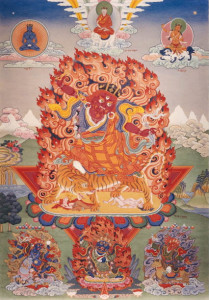

5–6pm Sādhana of Mahāmudrā
July 9, 2017 @ 8:00 am - 5:00 pm
The purpose of the sādhana:
“[The Sādhana’s] purpose was to bring together the two great traditions of the Vajrayāna, as well as to exorcise the materialism which seemed to pervade spiritual disciplines in the modern world. The message that I had received from my supplication was that one must try to expose spiritual materialism and all its trappings, otherwise true spirituality could not develop. I began to realize that I would have to take daring steps in my life.” – from Chögyam Trungpa’s Epilogue to Born in Tibet.
About the Sādhana
by Carolyn Rose Gimian
Adapted and excerpted from the Introduction to Volume Five of The Collected Works of Chögyam Trungpa. Introduction © 2004, Carolyn R. Gimian. Used by Arrangement with Shambhala Publications:
The Sadhana of Mahamudra, which Trungpa Rinpoche “discovered” in Bhutan in 1968, is a particular kind of text or teaching called terma. In Tibet, Chögyam Trungpa had already been recognized as a tertön, a teacher who “finds” or reveals terma, which are the teachings that Padmasambhava concealed in physical locations throughout Tibet and in the realm of mind and space. As Trungpa Rinpoche describes in Crazy Wisdom, “He [Padmasambhava] had various writings of his put in gold and silver containers like capsules and buried in certain appropriate places in the different parts of Tibet so that people of the future would rediscover them. … This process of rediscovering the treasures has been happening all along, and a lot of sacred teachings have been revealed. One example is the Tibetan Book of the Dead. Another approach to preserving treasures of wisdom is the style of the thought lineage. Teachings have been rediscovered by certain appropriate teachers who have had memories of them and written them down from memory. This is another kind of hidden treasure”. The Sadhana of Mahamudra is such a mind terma.
This text is particularly important because of how it joins together the teachings of both the Nyingma and Kagyü lineages. As Chögyam Trungpa says in the article, “Joining Energy and Space”: “The lineage of The Sadhana of Mahamudra is the two traditions of immense crazy wisdom and immense dedication and devotion put together. The Kagyü, or mahamudra tradition, is the devotion lineage. The Nyingma, or ati tradition, is the lineage of crazy wisdom. The sadhana brings these two traditions together as a prototype of how emotion and wisdom, energy and space, can work together.” Additionally, the sadhana contains a vivid description of the obstacles presented by physical, psychological, and spiritual materialism in the modern age and prescribes unwavering devotion to wakefulness as the antidote to the materialistic outlook.
For the remainder of Carolyn’s comments (including information by Richard Arthure who worked with Trungpa Rinpoche on the translation of the sadhana), see: http://www.chronicleproject.com/stories_110.html.
Carolyn finishes her comments:
As Richard also points out in his letter, after discovering and translating The Sadhana of Mahamudra, Trungpa Rinpoche was delighted to share this practice with anyone who might be interested. When he returned to England, his students there took up the practice of the sadhana immediately. … Once he arrived in America in 1970, in spite of his insistence on the sitting practice of meditation as the main discipline, Trungpa Rinpoche encouraged students to gather together and read the sadhana on the new and full moon. This practice continues to the present day.
